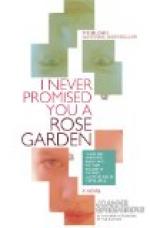The foxglove, one of the easily raised and very hardy plants, of majestic mien and great landscape value, will go on growing in one location for many years; but if you watch closely, you will find that it is rarely the original plant that has survived, but a seedling from it that has sprung up unobserved under the sheltering leaves of its parent. The old plant grows thick at the juncture of root stock and leaf, the action of the frost furrows and splits it, water or slugs gain an entrance, and it disappears, the younger growth taking its place. Especially true is this also of hollyhocks. The larkspurs have different roots and more underground vigour, and all tap-rooted herbs hold their own well, the difficulty being to curb their spreading and undermining their border companions.
[Illustration: ENGLISH LARKSPUR SEVEN FEET HIGH.]
It is conditions like these that keep the gardener of hardy things ever on the alert. Beds for annuals or florists’ plants are thoroughly dug and graded each spring, so that the weeds that must be combated are of new and comparatively shallow growth. The hardy bed, on the contrary, in certain places must be stirred with a fork only and that with the greatest care, for, if well-planned, plants of low growth will carpet the ground between tall standing things, so that in many spots the fingers, with a small weeding hoe only, are admissible. Thus a blade of grass here, some chickweed there, the seed ball of a composite dropping in its aerial flight, and lo! presently weedlings and seedlings are wrestling together, and you hesitate to deal roughly with one for fear of injuring the constitution of the other. To go to the other extreme and keep the hardy garden or border as spick and span clean as a row of onions or carrots in the vegetable garden, is to do away with the informality and a certain gracious blending of form and colour that is one of its greatest charms.
Thus it comes about, with the most successful of hardy mixed borders, that, at the end of the third season, things will become a little confused and the relations between certain border-brothers slightly strained; the central flowers of the clumps of phloxes, etc., grow small, because the newer growth of the outside circle saps their vitality.
Personally, I believe in drastic measures and every third or fourth year, in late September, or else April, according to season and other contingencies, I have all the plants carefully removed from the beds and ranged in rows of a kind upon the broad central walk. Then, after the bed is thoroughly worked, manured, and graded, the plants are divided and reset, the leavings often serving as a sort of horticultural wampum, the medium of exchange among neighbours with gardens, or else going as a freewill offering to found a garden for one of the “plotters” who needs encouragement.
The limitations of the soil of my garden and surroundings serve as the basis of an experience that, however, I have found carried out practically in the same way in the larger gardens of the Bluffs and in many other places that Evan and I have visited. So that any one thinking that a hardy garden, at least of herbaceous plants, is a thing that, once established, will, if not molested, go on forever, after the manner of the fern banks of the woods or the wild flowers of marsh and meadow, will be grievously disappointed.




